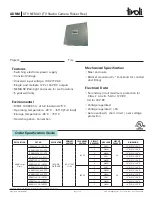
LEVEL and AI OUTPUT values
Basic configuration data is
Reconfigure the Probe Model and/or Probe
are inaccurate.
questionable.
Mount, Probe Length or Level Offset.
1) Ensure the Level is accurate.
2) Verify EU_0% and EU_100% values.
Interface level has significant emulsion. Examine process to reduce/eliminate
emulsion layer.
LEVEL readings are repeatable but
Configuration data does not
Ensure proper Probe Model and probe length.
consistently high or low from actual
accurately match probe length
by a fixed amount.
or tank height.
Adjust trim level value by the amount of
noted inaccuracy.
LEVEL and AI OUTPUT values
Turbulence
Increase the AI Block process value filter
fluctuate.
time until the readings stabilize.
High Frequency connection
Check Fid Spread (should be stable within
±10 counts).
LEVEL and AI OUTPUT values
Lower dielectric material over higher
Select Fixed Threshold option.
all reading low vs. actual.
dielectric material, e.g., oil over water
Coating, clumping or buildup on probe
These may be expected inaccuracies due
to affect on pulse propagation.
Dense, water based foam
These may be expected inaccuracies due
to affect on pulse propagation.
Level Reading on Display is stuck at
Software believes probe is flooded
Check actual level. If probe is not flooded,
full scale.
(level near very top of probe).
Check for buildup or obstructions near top
of probe. Select higher dielectric range.
Check for condensation in probe
connection. Add Blocking Distance.
LEVEL and AI OUTPUT values
Possible configuration issue
1) Increase Blocking Distance
values all at maximum level.
with single rod probe
2) Increase Dielectric Range
LEVEL and AI OUTPUT values
Possible obstruction in tank
1) Increase Dielectric Range until
reading high vs. actual.
affecting single rod probe
obstruction is ignored
2) Relocate probe away from obstruction
LEVEL value reading high when
Transmitter loose or disconnected
Ensure transmitter connected securely
should be zero.
from probe
to probe.
Symptom
Problem
Solution
7.1.1 troubleshooting System Problems
NOTE: When consulting the factory concerning improper operation, use proper tables on Pages 54-55. Enter all data when transmitter
is working CORRECTLY or INCORRECTLY.
7.0
Reference Information
7.1
Troubleshooting
The Eclipse transmitter is designed and engineered for
trouble-free operation over a wide range of operating
conditions. Common transmitter problems are discussed
in terms of their symptoms and recommended corrective
actions. Information on how to handle material buildup
on the probe is also provided in this section.
WARNING!
Explosion hazard. Do not connect or
disconnect equipment unless power
has been switched off or the area is
known to be non-hazardous.
40
57-640 Eclipse Guided Wave Radar Transmitter - F
OUNDATION
fieldbus
™
















































